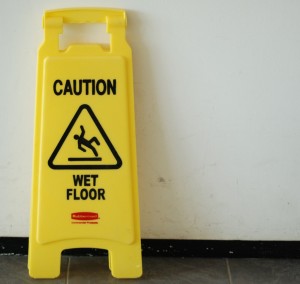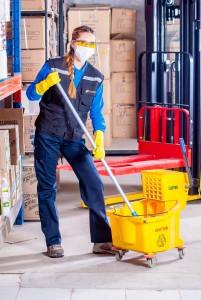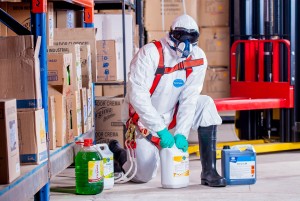In each newsletter we have been exploring the top 8 pieces of workplace health and safety legislation that you should be aware of.
And in this edition of our newsletter, we have chosen to talk about Reporting of Injuries, Diseases and Dangerous Occurrences Regulations 2013 and Provision and Use of Work Equipment Regulations 1998. Continue reading
In each newsletter we will be exploring the top 8 pieces of workplace health and safety legislation that you should be aware of.
In this edition of our newsletter, we have chosen to talk about Manual Handling Operations Regulations 1992 and Personal Protective Equipment at Work Regulations 1992.
Manual Handling Operations Regulations 1992
Under these regulations, to protect your workforce, you are required to:
Personal Protective Equipment at Work Regulations 1992
This section outlines that as an employer, you must:
Just like safety issues in the home, such as  maintaining electrical appliances and protecting children from hazardous materials, a workplace needs adequate maintenance and protection to keep employees safe. Sensitive problems such as bullying can be addressed by training and the implementation of proactive management policies, but other common health and safety hazards that can have a serious physical impact need to be addressed by supplying the correct safety equipment. Here is a quick guide to what employers should be aware of to ensure workplace safety.
maintaining electrical appliances and protecting children from hazardous materials, a workplace needs adequate maintenance and protection to keep employees safe. Sensitive problems such as bullying can be addressed by training and the implementation of proactive management policies, but other common health and safety hazards that can have a serious physical impact need to be addressed by supplying the correct safety equipment. Here is a quick guide to what employers should be aware of to ensure workplace safety.
When employees have to handle harmful or dangerous chemicals as part of their work, to stay safe, they must wear protective clothing, including specially treated gloves. It is also essential that any potentially harmful substances are labelled, and the correct signage is in place to warn of workplace hazards.
The Confined Spaces Regulations 1997 are intended to protect workers from unsafe work practices. As an employer, you need to ensure a safe work system is in place should it be necessary for anyone to enter a confined space in the workplace. That system is likely to include enforcing restricted entry policies and posting appropriate warning signs.
Electrical safety is an important issue in workplaces; especially where there is a risk that heavy-duty equipment might cause electric shocks. Warning signs must be in place, and information about how to treat victims of electric shock should be readily available.
Remember that extension leads may also be a safety hazard and use only surge-protected types in your workplace.
Forklift trucks are used in warehouses and yards for moving heavy loads from one area to another; they are also capable of inflicting serious injury unless safety guidelines are followed. Most responsible employers use floor signs to ensure drivers and pedestrians are aware when forklifts are operating in a particular area, as well as floor tape and wall signs to demarcate areas where forklifts are not permitted.
Using a lockout or tagout procedure ensures machinery is properly shut down after use and will not be operated again until it is safe to do so. It’s important to pay attention to lockout systems and procedures, as countless accidents occur every year when these are not implemented. Use high visibility lockout tags to indicate who is authorised to use machinery and when.
Your home is kept free from hazards by good housekeeping practices: spills are mopped up promptly to prevent slips and falls, visible dirt is cleaned away, and household waste is carefully disposed of. Those same principles apply to a workplace; so good housekeeping is an essential component of minimising accidents at work. It’s important to warn employees and customers when floors have been recently cleaned and may still be wet, or when cleaners are at work on-site dealing with waste.
Specialist equipment has made a great difference to the safety of employees who have to work at height. You can now source platforms with handrails, bespoke safety helmets and kits for roofers, so there’s no excuse for unsafe working practices that could cause harm.
 Maintaining high levels of hygiene should be an essential element of how any workplace operates. As an employer, the Health and Safety at Work Act 1974 requires you to have a general duty to ensure the health, safety and welfare of all your employees, so far as is ‘reasonably practical.’
Maintaining high levels of hygiene should be an essential element of how any workplace operates. As an employer, the Health and Safety at Work Act 1974 requires you to have a general duty to ensure the health, safety and welfare of all your employees, so far as is ‘reasonably practical.’
The issue of hygiene is a part of this legislation, so you need to be sure you are providing the facilities and information for your employees to create a hygienic and clean workplace.
Why is workplace hygiene important?
There are potential dangers for any workplace if there is little or no emphasis on why hygiene is important. Primary among these risks is the possibility of infection, whether it’s through poor personal hygiene, slapdash office cleaning or badly managed washroom facilities. You can prevent many of these problems by having a strategy for maintaining a hygienic workplace.
Personal hygiene
This refers to the habits, cleanliness and appearance of your employees. It can be a sensitive area for employers and managers, so an official policy can diffuse any awkwardness by setting down exactly what is expected from everyone. Depending on your business, there may be options to provide shower facilities if employees exercise before work or rely on a bike for transport, and you can ask that hair washing and grooming facial hair is a part of usual personal hygiene for work. Hand washing and the use of hand sanitisers are also key tools to help prevent the spread of illness.
Washroom facilities
Your policy on hygiene requirements should ensure that washrooms equipped with running cold and hot water are provided for all employees. You should also provide hand soap, toilet paper and towels for drying hands. This allows employees to attend to their personal hygiene when they have finished using the facilities. If you contract the cleaning of toilets and washrooms to an outside agency, you should be clear about the levels of cleanliness you require and how often cleaning should be done.
Kitchen
Kitchens can be a health risk if proper cleanliness is not observed. Any area where food is prepared or hot drinks are made should have a high level of cleaning, including preparation surfaces, utensils and cups, mugs, plates and cutlery, where provided. Your employees are entitled to complain if they consider there is a health risk through poor maintenance and cleaning of the kitchen area, but you can also encourage them to take responsibility to protect themselves and practice a good hygiene regime.
Office cleanliness
Employees should be encouraged to be responsible for cleaning and maintaining their own work areas or workstation. This can be part of your hygiene policy so everyone is aware of it and agrees with it. Surfaces can be cleaned with disinfectant to reduce the possibility of bacterial infection, and desks should be kept tidy and as clutter-free as possible. If employees have individual bins, it’s important to ensure these are emptied on a daily basis.
Good hygiene makes good sense
When your employees are aware of why it is important to have a hygienic workplace, they are more likely to follow your policy guidelines and create a pleasant and safe environment in which to do their jobs. If everyone is vigilant, sickness levels in the workplace can be significantly reduced.
 COSHH – Control of Substances Hazardous to Health – falls under the Control of Substances Hazardous to Health Regulations 2002. It requires that employers either prevent or reduce their staff’s exposure to materials that are dangerous to their health.
COSHH – Control of Substances Hazardous to Health – falls under the Control of Substances Hazardous to Health Regulations 2002. It requires that employers either prevent or reduce their staff’s exposure to materials that are dangerous to their health.
Many substances that are health hazards may appear obvious, such as chemicals and radiation, but you should also be aware that other substances can be harmful. Chemicals will have labels to warn you of their toxicity and danger, but other dangers include fumes and dust from sanding wood or from cutting silica. Bacteria also pose threats, and asbestos still appears in older buildings and should be removed safely.
In terms of health and safety, you must protect your employees from the potentially dangerous consequences of handling, manufacturing or being in areas where there are hazardous substances.
Harmful substances can get into the body in a number of ways. They could be breathed in or get onto the skin, thus damaging it, or in certain situations, they may permeate the skin, and enter the body that way. There is also a risk of swallowing a harmful substance, and you need to understand the effects of exposure by any of these routes.
Other considerations are how long people work with the substance and how often. Also be aware of those who could be exposed even if they do not work directly with a hazardous substance. It’s not just your workforce who could be affected, but also contractors, maintenance workers and other visitors, including members of the public. Cleaners or other part-time staff undertaking specific tasks may also be at risk of accidental exposure.
Legally, you must protect your employees with safe working practices, appropriate training and the right personal and protective equipment when required. Check legislation and regulation to keep your workforce safe and to protect your business.
It may not happen very often, but when the UK is sweltering in a heatwave it’s not always everyone’s idea of bliss.
There are regulations that govern the temperature of indoor workplaces, these are covered by the Workplace (Health, Safety and Welfare) Regulations 1992, they state that the minimum indoor workplace temperature should be at least 16C. If the work involves what is called ‘rigorous physical effort’, then the minimum temperature should be at least 13C.
However, the specified minimum temperatures are not absolute legal requirements, but the employer does have a duty to ensure staff work in reasonable comfort.
In terms of a maximum working temperature, the HSE do not specify a specific limit as high temperatures can vary in different workplaces – for example a kitchen and glass works. In high-temperature working environments such as these, the HSE says that it is still possible for employees to work safely providing that all necessary safety controls are in place.
Here are a few suggestions that employers could do:
Health and safety myths
If you have any questions relating to this newsletter, please contact Walker Health and Safety Services Limited. Info@walkersafety.co.uk 08458340400
Want to share this newsletter?
If you would like to print this newsletter we have created a formatted PDF version. You can download it here, print and distribute it accordingly.
With summer 2018 well under way, and having already brought heatwave weather conditions, now is a good time for employers to consider how to deal with dangers such as sunburn, skin cancer, dehydration and heat stress, in order to ensure safe and healthy working conditions for their outdoor workers.
For many workers, being free from the confines of an office and working outdoors, particularly in warm weather, is a welcome perk of certain jobs in the construction, leisure, entertainment, agriculture, sports and horticulture industries. However, the warm summer months pose certain risks to outdoor workers, which need to be adequately managed, just like any other health and safety risk.
Exposure to sunlight should not be viewed as unhealthy per se — it is well known that people need some sunshine to make enough vitamin D to build and maintain strong bones. However, sunlight contains ultraviolet radiation and too much sunlight can result in sunburn. Damage from sunburn can also have serious long-term effects, and frequent exposure to ultraviolet radiation for long periods of time increases the risk of developing skin cancer. Statistically, outdoor workers have higher risks of skin cancer than other workers due to longer periods of exposure and they are considered a high risk group in this regard.
Therefore, it is necessary to achieve a balance between sufficient sunlight and overexposure. It is not possible to give a one size fits all recommendation regarding the “safe” level of sunshine exposure as each individual will be different. Furthermore, skin cancer and sunburn are not the only risks to consider — there is also dehydration and heat stress, for example, both of which can be fatal. The key is to have in place a comprehensive outdoor working policy, able to cater for each individual outdoor worker and the range of potential risks.
Sunburn and skin cancers are not the only risks associated with outdoor work. Two other issues to consider are dehydration and heat stress. Symptoms of dehydration in outdoor workers might include indicators such as fatigue, poor concentration, fainting or headaches. In the worst-case scenario however, dehydration and heat stress can kill, as reported in the July 2013 case of three soldiers who died following a training exercise in the Brecon Beacons on an extremely hot day. The role of personal protective equipment is a particular factor to consider in relation to heat stress. On a hot day, someone wearing protective clothing and performing heavy work in hot and humid conditions could be at increased risk of heat stress. Ultimately, if the body is gaining more heat than it can lose, the deep body temperature will continue to rise. Eventually it reaches a point when the body’s control mechanism itself starts to fail.
The HSE says that when carrying out a heat stress risk assessment, the major factors to consider are:
Contact us should you require assistance.
Tips to Protect Workers that are Working In or Near Excavations
Contact us if you require further information.
| Advert |
Stress is back under the spotlight this month with National Stress Awareness Day on Wednesday 5th November. At this time of the year stress levels typically rise, because although nature may be slowing down and encouraging us to rest and retreat, our modern lives and work schedules continue to demand constant activity and productivity.
Winter offers an invitation to turn inward and recuperate. When we override this seasonal rest cycle by forcing ourselves to race on without refuelling we can begin to experience burnout. A common symptom of this is depression.
7 TIPS TO TRANSFORM DEPRESSION THIS WINTER
1. Listen – Allow the wisdom of your body to communicate with you by noticing the physical signs and symptoms it gives you rather than overriding them. Be kind to yourself. It is okay to feel low.
2. Pause – Give yourself permission to press pause, de-stress and take time out to rest.
3. Lighten Your Load – Let go of unnecessary commitments. Clear some space in your calendar so that you can slow down, indulge in some personal reflection and get more sleep.
4. Go Within – Use creative mediums like poetry, art, song, dance and body movement to explore and process your emotions, especially the ones you’ve felt unable to express in the past.
5. Remove the Mask – Make a list or draw pictures of all the things you pretend to be in your life. What are you putting up with? What are your frustrations? Where do you feel tension? By expressing these it becomes easier to go behind the mask you wear and rediscover who you truly are underneath.
6. Get Outside – Make an effort to get outside during the day and increase your exposure to daylight. This will help to boost your mood and is especially important during the winter months when there are shorter daylight hours.
7. Uncover Your Passions Connect with your true interests to boost your sense of self-fulfilment and help overcome depression. Lacking inspiration? Remember some of the things you used to love to do as a child and reignite old hobbies or experiment by trying something new.
NB: If you think you may be suffering from prolonged stress, depression or SAD consult your GP for further advice and information.